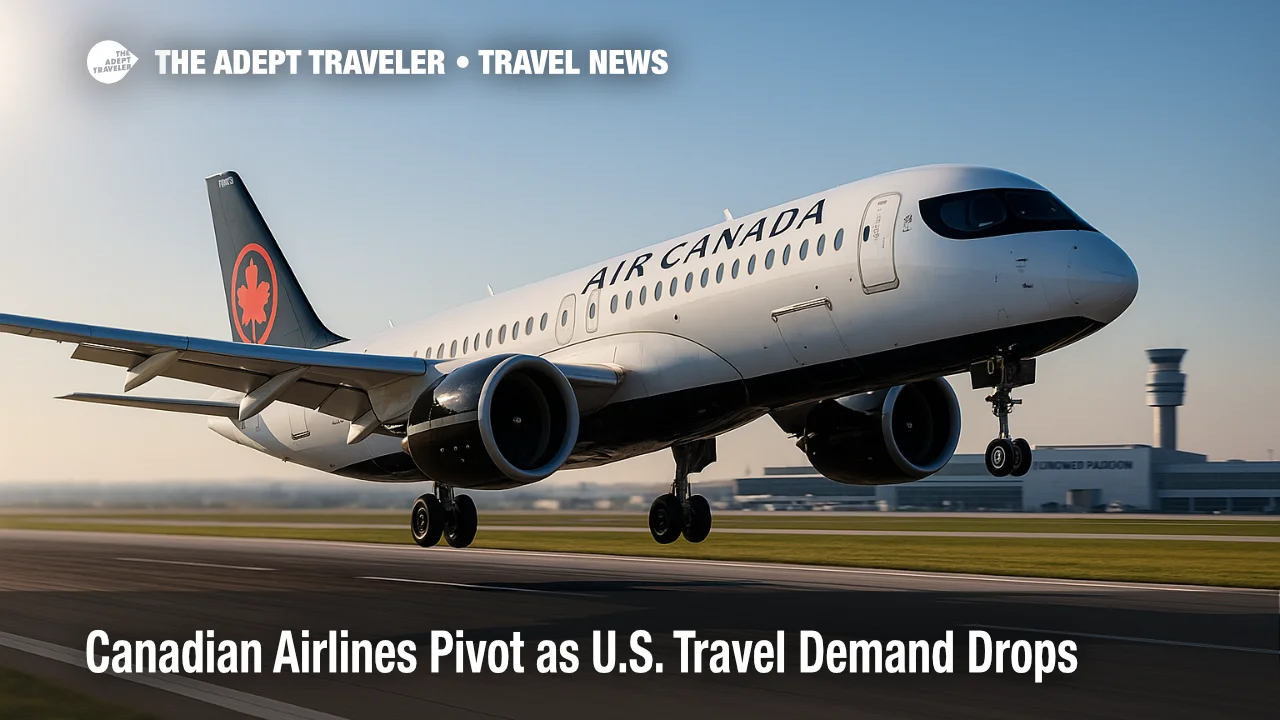Canadian airlines pivot as U.S. travel demand drops

Canadian airlines are recalibrating in response to a sharp fall in Canada to U.S. travel. Statistics Canada reports a 25.4% year-over-year decline in Canadian-resident air return trips from the United States in August. Air Canada cut third-quarter U.S. seats roughly 9% while bulking up Europe, Mexico, and Caribbean flying, and it now plans to restore transborder capacity next summer to prior levels. The stakes are rising as tariffs, political frictions, and U.S. rhetoric about winding down border preclearance inject uncertainty into 2026 schedules and traveler behavior.
Key points
- Why it matters: Transborder flying is a vital revenue stream for Canadian airlines.
- Travel impact: Weaker demand risks thinner schedules, higher fares, and longer connections.
- What's next: Air Canada targets a transborder rebuild in summer 2026 at 2024 levels.
- Porter's growth: More "sun" routes to Mexico, the Caribbean, and Latin America.
- Policy wild card: Talk of ending U.S. preclearance would disrupt hubs and connections.
Snapshot
The U.S. market slump is real. In August, Canadian-resident air return trips from the U.S. fell 25.4% year over year as sentiment cooled and tariffs bit. Air Canada trimmed third-quarter U.S. capacity about 9% and redirected flying across Europe, Mexico, and the Caribbean. The carrier still expects a winter bounce and, crucially, says it will bring U.S. capacity next summer back to 2024 levels, aided by new links such as Cleveland and Columbus to Montréal-Trudeau International Airport (YUL), and a Toronto Pearson International Airport (YYZ) return to San Antonio. The financial picture is mixed. Q2 operating margin was 7.4%, and August's four-day flight-attendant strike is expected to hit operating income by roughly $270 million. Preclearance rhetoric from Washington adds risk to airline scheduling and traveler itineraries.
Background
Transborder flying typically represents a significant revenue slice for Canada's flag carrier. With Canada to U.S. demand soft, airlines have been leaning into sun and long-haul flows. Porter is adding winter sun capacity up to 25% and introducing new routes to Mexico, the Caribbean, and Costa Rica, complementing its Embraer E195-E2 growth. Air Canada has nudged capacity toward Europe and Latin America while managing labor headwinds and macro uncertainty. At the same time, public comments from the U.S. ambassador about the cost of staffing U.S. border preclearance in Canada, a program dating to 1952, have unsettled the industry. If preclearance were curtailed, passengers arriving stateside would face longer lines, and Canadian carriers would lose a competitive edge for one-stop Europe via Canadian hubs.
Latest developments
Air Canada signals a summer rebuild in transborder travel
Air Canada's U.S. seat count was down year over year in the third quarter, but the airline says it intends to return next summer's transborder capacity to summer 2024 levels. Newly announced routes support that plan, including daily Montréal service to Cleveland Hopkins International Airport (CLE) and John Glenn Columbus International Airport (CMH) from May 1, 2026, and a Toronto, San Antonio link at San Antonio International Airport (SAT). These additions coincide with a broader 15% boost to U.S. capacity in summer 2026 versus summer 2025. The strategy banks on a winter thaw in demand, pent-up family and property ties in the U.S., and smoother connections through YYZ and YUL to Europe. Execution will hinge on policy stability, successful arbitration after the August strike, and maintaining margins after a soft second quarter.
Analysis
For travelers and the trade, two forces will shape the next twelve months. First, sentiment and pricing. Tariff headlines and political friction have cooled discretionary trips, especially leisure short breaks and small-business travel that drive shoulder-season transborder demand. Airlines responded with rational capacity cuts and redeployment to resilient flows, notably Europe and sun markets, which cushions yields but reduces nonstop choice to the U.S. Second, policy risk. The ambassador's suggestion that the United States might "take a look" at preclearance raises operational stakes. Preclearance underpins the competitiveness of Canadian hubs by turning U.S. arrivals into domestic flows, unlocking tighter connections and better missed-connection recovery. Removing it would snarl itineraries, pressure minimum connection times, and likely shift some connecting traffic to U.S. hubs. Against this, Air Canada's plan to restore 2024-level transborder capacity, plus added spokes at CLE, CMH, and SAT, signals confidence that winter will bring a rebound. Watch seat maps and fares from late November, when snow and school breaks test the thesis.
Final thoughts
Expect a pragmatic winter. Airlines will keep trimming where needed, then rebuild for summer if bookings firm. Porter's sun push and Air Canada's 2026 route adds suggest carriers are positioning for normalized cross-border flows. If preclearance stays intact and tariffs cool, schedules should stabilize, connections through YYZ and YUL will regain their edge, and Canadian carriers will claw back share. If policy turns harsher, travelers should budget extra time and consider alternative routings. Either way, the transborder story will continue to hinge on Canadian sentiment and the operational advantages that matter most to Canadian airlines.
Sources
- Leading indicator of international arrivals to Canada, Statistics Canada
- Air Canada reports second quarter 2025 financial results, Air Canada newsroom
- Air Canada expects operating income hit of $270 million due to labor disruptions, Reuters
- Airlines cut capacity between Canada and the U.S., Cirium
- Air Canada adds select transborder routes for summer 2026, Air Canada newsroom
- Air Canada announces new daily nonstop service between Cleveland and Montréal, Cleveland Hopkins International Airport
- New nonstop flight Montréal, Columbus starting May 1, 2026, John Glenn Columbus International Airport
- U.S. customs preclearance at Canadian airports under scrutiny, Travelweek
- Porter Airlines increases sun destination capacity and launches four new winter routes, Business Wire
